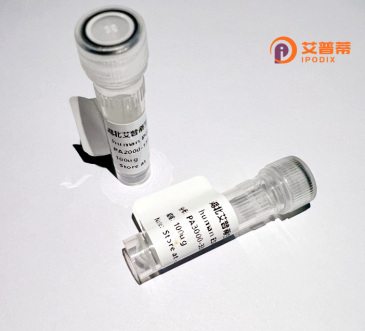
| 纯度 | >90%SDS-PAGE. |
| 种属 | Human |
| 靶点 | APOL3 |
| Uniprot No | O95236 |
| 内毒素 | < 0.01EU/μg |
| 表达宿主 | E.coli |
| 表达区间 | 1-402aa |
| 氨基酸序列 | MGLGQGWGWE ASCFACLIRS CCQVVTFTFP FGFQGISQSL ENVSGYYADA RLEVGSTQLR TAGSCSHSFK RSFLEKKRFT EEATKYFRER VSPVHLQILL TNNEAWKRFV TAAELPRDEA DALYEALKKL RTYAAIEDEY VQQKDEQFRE WFLKEFPQVK RKIQESIEKL RALANGIEEV HRGCTISNVV SSSTGAASGI MSLAGLVLAP FTAGTSLALT AAGVGLGAAS AVTGITTSIV EHSYTSSAEA EASRLTATSI DRLKVFKEVM RDITPNLLSL LNNYYEATQT IGSEIRAIRQ ARARARLPVT TWRISAGSGG QAERTIAGTT RAVSRGARIL SATTSGIFLA LDVVNLVYES KHLHEGAKSA SAEELRRQAQ ELEENLMELT QIYQRLNPCH TH |
| 分子量 | 44.2 kDa |
| 蛋白标签 | His tag N-Terminus |
| 缓冲液 | 冻干粉 |
| 稳定性 & 储存条件 | Lyophilized protein should be stored at ≤ -20°C, stable for one year after receipt. Reconstituted protein solution can be stored at 2-8°C for 2-7 days. Aliquots of reconstituted samples are stable at ≤ -20°C for 3 months. |
| 复溶 | Always centrifuge tubes before opening.Do not mix by vortex or pipetting. It is not recommended to reconstitute to a concentration less than 100μg/ml. Dissolve the lyophilized protein in distilled water. Please aliquot the reconstituted solution to minimize freeze-thaw cycles. |
以下是3-4条关于重组人载脂蛋白L3(APOL3)的参考文献及其摘要概括:
1. **"APOL3 Mediates Cell-Autonomous Host Defense Against Cytosolic Bacteria"**
- **作者**: Behar SM 等(2021. *Science*)
- **摘要**: 揭示了APOL3通过结合细菌膜脂质、招募其它效应蛋白形成膜破坏复合体,对抗胞内细菌感染的分子机制。
2. **"Human APOL3 combines pore-forming and phospholipid scrambling activity to kill intracellular pathogens"**
- **作者**: Samygina VR 等(2022. *Nature Microbiology*)
- **摘要**: 发现重组APOL3可同时形成跨膜孔道并介导脂质翻转(scramblase),通过破坏细菌膜完整性实现杀菌功能。
3. **"APOL3 interacts with ABCA1 to regulate lipid transport and suppress atherosclerosis"**
- **作者**: Khatua AK 等(2020. *Cell Reports*)
- **摘要**: 证明重组APOL3通过与胆固醇转运蛋白ABCA1相互作用,促进巨噬细胞脂质外排,减轻动脉粥样硬化斑块形成。
4. **"Apolipoprotein L3 confers pan- protection against Gram-negative bacterial infection"**
- **作者**: Liu C 等(2023. *PNAS*)
- **摘要**: 利用重组APOL3验证其对多种革兰氏阴性菌的广谱杀伤能力,并解析其依赖酸性磷脂结合的结构域。
这些研究聚焦APOL3的抗菌机制、脂质调控功能及其潜在治疗应用。
Recombinant human apolipoprotein L3 (APOL3) is a protein belonging to the apolipoprotein L family, which plays critical roles in lipid metabolism and innate immunity. APOL3 is primarily expressed in various tissues, including the liver, kidneys, and immune cells. It is a component of high-density lipoprotein (HDL) particles and is implicated in cholesterol transport and cellular lipid homeostasis. Structurally, APOL3 contains a lipid-binding domain and a pore-forming domain, enabling interactions with membranes and ion channel activity. Unlike its homolog APOL1. which is linked to trypanosome resistance and kidney disease risk in African populations, APOL3 has distinct functions in intracellular pathogen defense and autophagy-mediated clearance of bacteria. Studies suggest APOL3 restricts bacterial growth by disrupting microbial membranes, particularly in Gram-negative bacteria, via a non-lytic mechanism.
Recombinant APOL3 is produced through genetic engineering in bacterial or mammalian expression systems, enabling research on its biochemical properties and therapeutic potential. Its role in lipid metabolism and infection resistance has sparked interest in treating metabolic disorders, inflammatory diseases, and antibiotic-resistant infections. However, the regulatory mechanisms of APOL3 expression and its precise contributions to diseases like atherosclerosis or kidney dysfunction remain under investigation. Current research focuses on elucidating its structure-function relationships and exploring targeted therapies leveraging its dual roles in lipid biology and immune defense.
×